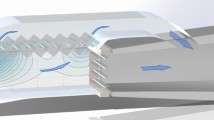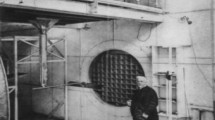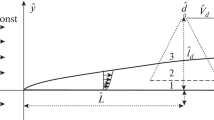Abstract
In contrast to the well-known solutions in which the condition at the stream boundaries has the same form for all walls of the tunnel, in the present formulation the stream boundaries are divided into sections of two types with different boundary conditions. These conditions are general for any Mach numbers. The plane limiting boundary problem on the subsonic flow over a dipole is solved in elementary functions for the case of small velocity perturbations at the stream boundary and a low perforation factor. The solution obtained, while not coinciding with the solution for the case of unperforated walls everywhere when the perforation factor equals zero, gives a simple rule for allowing for induction.
Similar content being viewed by others
Literature cited
G. L. Grodzovskii, A. A. Nikol'skii, G. P. Svishchev, and G. I. Taganov, Supersonic Gas Flow in Perforated Boundaries [in Russian], Mashinostroenie, Moscow (1967).
C. F. Lo and R. H. Oliver, “Subsonic lift interference in a wind tunnel with perforated walls,” J. Aircr.,7, No. 3 (1970).
M. Mokry, “A wake-blockage paradox in a perforated wall wind tunnel,” AIAA J.,9, No. 12 (1971).
H. Ashley and M. Landahl, Aerodynamics of Wings and Bodies, Addison-Wesley (1965).
Author information
Authors and Affiliations
Additional information
Translated from Izvestiya Akademii Nauk SSSR, Mekhanika Zhidkosti i Gaza, No. 6, pp. 130–136, November–December, 1977.
Deceased.
Rights and permissions
About this article
Cite this article
Marevtseva, N.A. Induction of subsonic wind tunnels with slight perforation. Fluid Dyn 12, 922–928 (1977). https://doi.org/10.1007/BF01090330
Received:
Issue Date:
DOI: https://doi.org/10.1007/BF01090330




